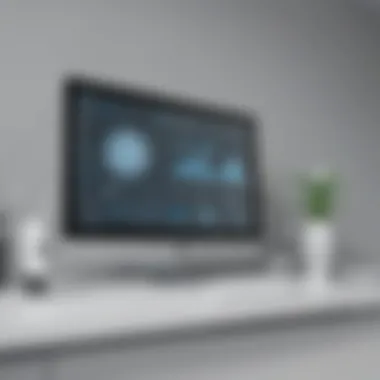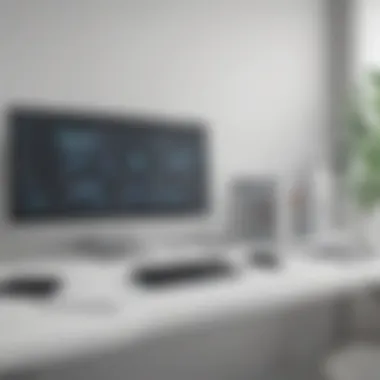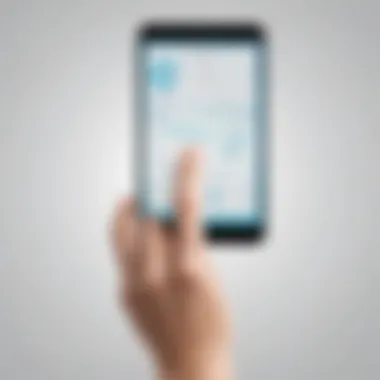Revolutionizing Personal Care Homes: The Impact of Advanced Software Solutions


Software Overview
In the landscape of personal care homes, the utilization of advanced software solutions has brought forth a paradigm shift. These cutting-edge tools encompass a spectrum of functionalities, prominently featuring electronic health records and refined scheduling systems. By embracing these innovative software technologies, care facilities can witness a substantial enhancement in operational efficiency, elevated quality of resident care, and a streamlined approach to administrative processes.
User Experience
User experience within personal care homes has undergone a transformative evolution with the integration of sophisticated software solutions. The user interface manifests user-friendly design elements, coupled with intuitive navigational aids that facilitate seamless interaction. The software extolls an accessible learning curve, ensuring that staff members can quickly adapt to its functionalities. Moreover, the availability of robust customer support options bolsters reliability, underpinning a smooth operational environment.
Performance and Reliability
The performance metrics of these advanced software solutions are primed to redefine the operational standards within care facilities. A remarkable focus on speed and efficiency characterizes the functionality of the software, optimizing workflow processes and minimizing redundancies. To ensure continuous functionality, the software boasts impressive uptime statistics, mitigating potential downtimes and service interruptions. Furthermore, its integration capabilities with other tools foster a holistic ecosystem of technological efficiency.
Security and Compliance
Security and compliance represent non-negotiable pillars in the realm of personal care homes. The software solutions encapsulate stringent data encryption protocols, safeguarding sensitive information against potential breaches. Moreover, the software aligns with industry-specific regulations, ensuring compliance with mandated standards. To fortify its resilience, the software incorporates robust backup and disaster recovery measures, insulating against unforeseen contingencies.
Foreword
Personal care homes have embarked on a groundbreaking journey of transformation through the integration of cutting-edge software solutions. This article delves deep into the realm of revolutionizing personal care homes, showcasing the pivotal role advanced software plays in enhancing operational efficiency, elevating resident care quality, and streamlining administrative processes. By adopting innovative technologies like electronic health records and scheduling systems, care facilities are poised to achieve unprecedented levels of optimization and ensure the well-being of residents.
Significance of Software in Personal Care Homes
Enhancing Operational Efficiency
Delving into the realm of enhancing operational efficiency within personal care homes, one encounters a transformative approach to optimizing daily processes. The key characteristic of this enhancement lies in its ability to streamline tasks, reduce redundancies, and improve overall workflow. The unique feature of operational efficiency enhancement is its capacity to expedite crucial activities, leading to heightened productivity and resource utilization. This strategic choice within the context of this article stems from its proven track record in significantly enhancing care delivery and operational performance.
Improving Resident Care Quality
The pursuit of elevating resident care quality stands out as a paramount objective in personal care homes. This aspect focuses on enhancing the well-being and satisfaction of residents through personalized and efficient care methodologies. The distinctive characteristic of resident care quality improvement is its emphasis on individualized attention and holistic care approaches. Within this article, this emphasis is highlighted as a critical choice due to its profound impact on resident outcomes and overall care standards.
Streamlining Administrative Processes
The optimization of administrative processes represents a fundamental facet of modernizing personal care home operations. Streamlining administrative tasks involves simplifying complex procedures, reducing paperwork, and enhancing communication channels. The noteworthy attribute of this process is its ability to improve efficiency, decision-making, and data management. Within the context of this article, the choice to streamline administrative processes is deemed essential for driving organizational effectiveness and fostering a culture of continuous improvement.
Purpose of the Article
Highlighting Benefits of Personal Care Home Software Integration
In elucidating the benefits of integrating software solutions in personal care homes, a profound narrative unfolds. This aspect focuses on showcasing how software integration translates into operational excellence, cost-effectiveness, and resident satisfaction. The distinctive characteristic of this integration is its ability to align technology with care delivery, ensuring seamless and patient-centric services. Within this article, the emphasis lies on portraying software integration as a catalyst for transformative change, underlining its advantages in driving optimal outcomes and organizational success.
Overview of Personal Care Home Software
Key Features and Functionalities


Exploring the key features and functionalities of personal care home software reveals a landscape rich in innovation and efficiency. The essence of these features lies in their ability to centralize data, automate tasks, and facilitate informed decision-making. The unique aspect of these functionalities is their capacity to enhance care coordination, minimize errors, and improve overall service delivery. Within this article, the significance of key features and functionalities is underscored for its role in elevating care standards and operational performance.
Importance of Customization
Recognizing the importance of customization in personal care home software unveils a tailored approach to addressing unique facility needs. The core characteristic of customization is its ability to adapt technology to specific workflows, preferences, and requirements. The distinctive feature of customization is its capacity to enhance user experience, promote technological adoption, and drive strategic innovation. Within this article, the emphasis on customization is pivotal for showcasing the relevance of personalized solutions in optimizing care delivery and organizational efficiency.
Benefits of Personal Care Home Software
Personal care home software plays a crucial role in revolutionizing care facilities, enhancing efficiency, and ensuring resident well-being. By integrating advanced software solutions tailored to the specific needs of personal care homes, organizations can streamline operations, improve overall care quality, and optimize administrative processes. The benefits of personal care home software are multifaceted, ranging from enhancing resident management to promoting staff coordination and efficient resource allocation. Understanding the significance of this topic is pivotal for small to medium-sized businesses, entrepreneurs, and IT professionals seeking to leverage technology for enhancing care services.
Enhanced Resident Management
Efficient Electronic Health Records Management
Efficient electronic health records (EHR) management is a cornerstone of modern personal care home software solutions. This aspect focuses on streamlined digital record-keeping, ensuring comprehensive and accurate documentation of residents' health information. The key characteristic of efficient EHR management lies in its ability to centralize data, facilitate quick access to critical health records, and track residents' medical histories effectively. By adopting efficient EHR management, care facilities can enhance diagnostic accuracy, improve care coordination among staff members, and elevate the quality of resident care delivery. Although implementing efficient EHR management requires initial training and investment, the long-term benefits in terms of operational efficiency and resident well-being make it a valuable choice for personal care homes.
Real-time Monitoring of Resident Activities
Real-time monitoring of resident activities harnesses technology to track and analyze resident behaviors and movements continuously. This monitoring capability provides care staff with instant insights into residents' daily activities, enabling proactive intervention in case of emergencies or deviations from routine behaviors. The key characteristic of real-time monitoring lies in its ability to offer real-time updates on residents' well-being, ensuring prompt responses to any changes in health status. The unique feature of real-time monitoring is its capacity to enhance resident safety, prevent accidents, and improve overall care quality. Despite some privacy concerns associated with constant monitoring, the advantages of real-time tracking in terms of resident safety and well-being justify its integration into personal care home software systems.
Improved Staff Coordination
Optimized Shift Scheduling
Optimized shift scheduling features advanced algorithms that streamline the allocation of staff resources based on resident needs and care requirements. This aspect focuses on creating efficient and fair schedules, considering factors such as staff availability, skills, and individual preferences. The key characteristic of optimized shift scheduling is its ability to minimize conflicts, reduce overtime expenses, and ensure adequate staffing levels at all times. By implementing optimized shift scheduling, care facilities can enhance staff satisfaction, improve continuity of care for residents, and optimize operational costs. While adjusting to a new scheduling system may pose challenges initially, the long-term benefits in terms of staff morale and operational efficiency make it a valuable choice for personal care homes.
Communication Enhancements
Communication enhancements aim to improve information exchange and collaboration among care team members through integrated communication tools. This aspect focuses on facilitating inter-departmental communication, sharing vital updates, and ensuring timely responses to resident needs. The key characteristic of communication enhancements is their role in promoting real-time information sharing, enhancing team cohesion, and fostering a culture of transparency in care delivery. The unique feature of communication enhancements lies in their capacity to reduce communication barriers, increase staff efficiency, and ultimately enhance the quality of resident care. Despite potential challenges in terms of staff training on new communication platforms, the benefits of streamlined communication processes justify the adoption of such enhancements in personal care home software environments.
Efficient Resource Allocation
Inventory Management
Inventory management functionality enables care facilities to track, manage, and optimize the utilization of essential supplies, medications, and equipment. This aspect focuses on maintaining accurate inventory records, automating reorder processes, and preventing stock shortages or wastage. The key characteristic of inventory management is its capacity to enhance cost-effectiveness, minimize inventory-related errors, and ensure seamless supply chain management within care settings. The unique feature of inventory management is its ability to streamline procurement processes, reduce operational costs, and improve overall resource utilization. While transitioning to a digital inventory management system may require initial adjustments and training, the long-term benefits in terms of cost savings and operational efficiency make it a prudent choice for personal care homes.
Budgeting Tools
Budgeting tools offer financial management support by providing budget planning, forecasting, and variance analysis capabilities. This aspect focuses on empowering care facility administrators to make informed financial decisions, allocate resources effectively, and monitor expenditure against budget targets. The key characteristic of budgeting tools is their ability to enhance financial transparency, optimize resource allocation, and identify cost-saving opportunities within care operations. The unique feature of budgeting tools lies in their capacity to streamline budgeting processes, improve financial accountability, and ensure fiscal sustainability for personal care homes. Despite potential challenges in terms of staff training on financial software platforms, the advantages of precise budgeting and financial planning justify the implementation of budgeting tools to support operational success within care environments.
Implementing Personal Care Home Software
Implementing Personal Care Home Software is a critical aspect within the landscape of personal care facilities, central to the efficient and effective operation of such establishments. The integration of software solutions tailored specifically for the unique needs of personal care homes is paramount in achieving optimal performance levels and ensuring the well-being of residents. By incorporating advanced software tools, these facilities can streamline processes, enhance resident care, and boost overall operational efficiency. Through this comprehensive approach, personal care homes can leverage technology to navigate challenges and deliver quality care with precision and accuracy.


Assessing Facility Needs
Conducting Workflow Analysis
Within the realm of Assessing Facility Needs, Conducting Workflow Analysis emerges as a pivotal component in the strategic implementation of personal care home software. This process involves a meticulous examination of operational workflows to identify inefficiencies, redundancies, and areas for improvement. By scrutinizing the intricacies of daily routines and care procedures, facilities can pinpoint bottlenecks and streamline processes to enhance efficiency and resident satisfaction. Conducting Workflow Analysis serves as a foundational step in optimizing workflow management and aligning software solutions with the precise needs of the facility.
Identifying Pain Points
In the realm of Assessing Facility Needs, Identifying Pain Points plays a crucial role in recognizing operational challenges and areas of concern within personal care homes. By delving into the specific pain points experienced by staff and residents, facilities can address root causes and implement targeted solutions to alleviate these issues effectively. This proactive approach enables personal care homes to enhance service delivery, elevate staff morale, and improve overall resident satisfaction. Identifying Pain Points serves as a proactive strategy to preemptively tackle challenges and ensure a seamless transition to new software solutions.
Selecting the Right Software
Researching Available Options
Selecting the Right Software commences with a thorough exploration of Researching Available Options, a process critical in aligning software solutions with the unique requirements of personal care facilities. Conducting comprehensive research enables facilities to evaluate the features, functionalities, and compatibility of various software options based on their specific needs. Through this systematic approach, personal care homes can identify solutions that offer seamless integration, scalability, and customization capabilities to address their operational challenges effectively. Researching Available Options empowers facilities to make informed decisions and select software solutions that enhance efficiency and resident care quality.
Seeking Customization Possibilities
Within the domain of Selecting the Right Software, Seeking Customization Possibilities emerges as a pivotal strategy in tailoring software solutions to meet the distinct requirements of personal care homes. By exploring customization options, facilities can adapt software functionalities to align with their operational workflows, care protocols, and resident management processes. This bespoke approach allows personal care homes to leverage software features that address specific pain points, enhance staff productivity, and optimize overall performance. Seeking Customization Possibilities facilitates the seamless integration of software solutions tailored to the unique needs of each facility.
Training and Implementation Process
Staff Training Programs
Training and Implementation Process encompass the deployment of Staff Training Programs, essential in preparing personnel for the integration of new software solutions within personal care homes. These programs aim to familiarize staff with the functionalities, navigation, and usage of software systems to ensure a smooth transition and optimal utilization. By equipping employees with the necessary skills and knowledge, staff training programs empower them to leverage software tools effectively, enhance operational efficiency, and deliver quality care to residents. Staff Training Programs play a pivotal role in facilitating a cohesive transition to advanced software solutions, promoting staff confidence and proficiency in software utilization.
Integration Strategies
Moreover, Integration Strategies play a crucial role in harmonizing software systems with existing operational frameworks within personal care homes. By developing integration strategies tailored to the facility's specific needs, organizations can seamlessly incorporate software solutions into their daily routines and care practices. These strategies focus on mitigating disruption, optimizing connectivity, and fostering a collaborative approach to software implementation. Integration Strategies ensure a coordinated effort towards adopting advanced software solutions, maximizing their potential impact on resident care quality and operational efficiency.
Challenges in Personal Care Home Software Adoption
Personal care home software adoption poses significant challenges that must be addressed with precision and care. In this article, we delve into the complexities of implementing advanced software solutions within care facilities and the crucial considerations that decision-makers must navigate. By understanding the specific elements, benefits, and considerations surrounding challenges in software adoption, organizations can mitigate risks and optimize outcomes effectively.
Cost Considerations
Initial Investment vs. Long-term Savings
In the realm of personal care home software adoption, the comparison between initial investments and long-term savings holds paramount importance. The decision to invest in software solutions necessitates a comprehensive evaluation of short-term financial outlays against the potential returns over an extended period. The key characteristic of this comparison lies in identifying the balance between immediate costs and future benefits. Delving into the unique feature of this analysis, organizations can strategically allocate resources to maximize efficiency and resident care. While initial investments may seem burdensome, the promise of long-term savings through operational enhancements and streamlined processes makes it a prudent choice for care facilities seeking sustainable improvements.
Budget Constraints
Another pressing aspect of software adoption in personal care homes revolves around managing budget constraints efficiently. Careful consideration of financial limitations is crucial in selecting software solutions that align with the organization's fiscal capabilities while delivering significant value. The key characteristic here is the need to optimize resource utilization without compromising on quality or functionality. Despite the challenges posed by budget constraints, creative solutions and prudent decision-making can pave the way for cost-effective software integration. Navigating these constraints effectively allows care facilities to enhance operational efficacy without straining financial resources.


Staff Resistance to Change
Effective implementation of personal care home software is contingent upon overcoming staff resistance to change, a ubiquitous challenge in the realm of healthcare technology adoption. Addressing specific aspects such as training needs is pivotal in preparing staff members for the transition towards digital solutions. The key characteristic of addressing training requirements lies in fostering a comprehensive understanding of new systems and processes among personnel. By highlighting the benefits of training initiatives, organizations can instill confidence and competence in employees, facilitating a smoother transition to software-driven operations.
Cultural Shifts
Accompanying staff resistance to change are the cultural shifts that accompany the adoption of software in care facilities. Recognizing and addressing these shifts is imperative in ensuring organizational readiness and alignment with technological advancements. The key characteristic of navigating cultural transitions is the ability to cultivate a supportive environment that embraces innovation and change. By promoting a culture of adaptation and continuous improvement, care facilities can empower their teams to leverage software solutions effectively, driving enhanced performance and resident care.
Data Security and Compliance
The critical nature of data security and compliance in personal care home software adoption cannot be understated. Robust adherence to regulations such as HIPAA compliance is essential in safeguarding sensitive resident information and maintaining confidentiality. The key characteristic of HIPAA compliance lies in the stringent protocols and safeguards implemented to protect privacy and uphold ethical standards. Emphasizing the importance of data privacy ensures that care facilities uphold the trust of residents and comply with industry regulations seamlessly.
Ensuring Data Privacy
Beyond regulatory compliance, ensuring data privacy is a multifaceted aspect of software adoption in personal care homes. The key characteristic of data privacy measures lies in the proactive strategies implemented to prevent breaches and unauthorized access to resident information. By prioritizing data encryption, restricted access protocols, and secure data management practices, care facilities can fortify their defenses against potential cyber threats and data vulnerabilities. Ensuring comprehensive data privacy not only safeguards resident confidentiality but also enhances the overall trust and credibility of care facilities in the healthcare landscape.
Future Trends in Personal Care Home Software
As we delve into the future trends of personal care home software, it becomes evident that the integration of artificial intelligence (AI) and Internet of Things (IoT) technologies is revolutionizing the landscape of elderly care. The amalgamation of AI and IoT offers unparalleled opportunities to enhance resident well-being, improve operational efficiency, and streamline caregiving processes. This forward-looking approach not only anticipates the needs of residents but also empowers care providers to deliver personalized and proactive care services.
Integration of AI and IoT
Predictive Analytics for Care Needs
The utilization of predictive analytics for care needs represents a groundbreaking advancement in the realm of personal care homes. By analyzing vast amounts of data from various sources, predictive analytics can forecast potential health issues or care requirements for residents. This proactive approach enables caregivers to intervene early, thus preventing emergencies and ensuring proactive health management. The key characteristic of predictive analytics lies in its ability to harness data to anticipate trends and tailor care plans accordingly, making it a valuable asset for enhancing resident outcomes and operational efficiency.
Smart Home Technology Integration
Incorporating smart home technology into personal care facilities revolutionizes the way residents interact with their living spaces. Smart devices and sensors can monitor vital signs, detect emergencies, and automate routine tasks, promoting independence and safety for residents. The key characteristic of smart home technology integration is its seamless integration with existing care processes, creating a connected environment that enhances resident quality of life. While the unique feature of this integration lies in its ability to adapt to individual preferences, there may be concerns regarding data privacy and reliance on technology in caregiving.
Mobile Accessibility
Remote Monitoring Apps
Remote monitoring apps cater to the evolving needs of caregivers by providing real-time access to residents' health data and activity levels. This instant access enables caregivers to respond promptly to emergencies, track trends in residents' health status, and ensure continuity of care. The key characteristic of remote monitoring apps is their ability to bridge the gap between caregivers and residents, facilitating efficient communication and decision-making. While remote monitoring apps offer convenience and oversight, challenges may arise concerning data security and the need for staff training to fully leverage this technology.
Mobile Care Collaboration Platforms
Mobile care collaboration platforms redefine communication and collaboration among care team members, residents, and families. These platforms enable real-time information sharing, care coordination, and instant access to care plans, promoting efficient and transparent caregiving practices. The key characteristic of mobile care collaboration platforms is their ability to centralize communication channels and streamline care workflows, fostering multidisciplinary teamwork and resident-centered care. However, concerns may arise regarding the integration of these platforms with existing systems and ensuring data accuracy and confidentiality.
Enhanced Data Analytics
Real-time Reporting Dashboards
Real-time reporting dashboards offer valuable insights into operational metrics, resident health trends, and care outcomes, empowering decision-makers with actionable data. These dashboards provide a comprehensive overview of facility performance, resource allocation, and resident satisfaction levels in a visually engaging format. The key characteristic of real-time reporting dashboards is their capacity to convert complex data into actionable intelligence, facilitating data-driven decision-making and continuous quality improvement. Despite their benefits, challenges such as data accuracy, system integration, and user training may impact the effectiveness of real-time reporting dashboards.
Customizable Analytics Tools
Customizable analytics tools provide personal care home administrators with the flexibility to tailor data analysis to their specific needs and goals. These tools offer advanced functionalities for data visualization, trend analysis, and performance monitoring, enabling administrators to track key performance indicators and identify areas for improvement. The key characteristic of customizable analytics tools is their adaptability to different user preferences and requirements, allowing for customizable reports and insights. While these tools enhance data interpretation and strategic planning, considerations around data security, data governance, and skill requirements for utilization may arise in the implementation process.







